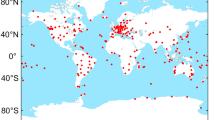Abstract
The pulse phase and doppler frequency estimation of X-ray pulsars in dynamic situations and its application in navigation is a problem that has not been fully investigated. In this paper, solutions are proposed to solve this problem under conditions of spacecraft and binary motion. A high-precision doppler frequency (velocity) measurement model as well as a phase (range) measurement model is established. The averaged maximum-likelihood estimator is developed for the dynamic pulse phase estimation. The pulse phase tracking technique is used in the doppler frequency determination. The tracking filter is redesigned and compared with the existing algorithms. The comparison verifies the advantage of the filter algorithm presented in this paper. Unlike traditional views, it is found that in dynamic situations, shorter observation interval lengths will result in higher-accuracy phase and frequency estimates as the tracking filter outputs. A photon-level integrated numerical simulation is performed. Simulation results testify to the validity of the proposed phase and doppler frequency estimation scheme, and show that incorporation of velocity measurements as well as the range ones into the navigation estimator will improve the navigation steady-state performance.
Similar content being viewed by others
References
Hanson J E. Principles of X-ray Navigation. Dissertation for the Doctoral Degree. Stanford: Stanford University, 1996
Sheikh S I, Pines D J. Spacecraft navigation using X-ray pulsars. J Guid Control Dyam, 2006, 29: 49–63
Sheikh S I. The Use of Variable Celestial X-ray Sources for Spacecraft Navigation. Dissertation for the Doctoral Degree. College Park: Maryland University, 2005
Golshan A R, Sheikh S I. On pulse phase estimation and tracking of variable celestial X-ray sources. In: ION 63rd Annual Meeting, Cambridge, MA. Cambridge: ION, 2007. 413–422
Ashby N, Golshan A R. Minimum uncertainties in position and velocity determination using X-ray photons from millisecond pulsars. In: ION NTM, San Diego, CA. San Diego: ION, 2008. 110–118
Emadzadeh A A. On modeling and pulse phase estimation of X-ray pulsars. IEEE Trans Signal Process, 2010, 58(9): 4484–4495
Sala J, Urruela A, Villares X, et al. Feasibility study for a spacecraft navigation system relying on pulsar timing information. ARIADNA study 03/4202, 2004
Hobbs G B, Edwards R T, Manchester R N. TEMPO2, a new pulsar-timing package-I. An overview. Mon Not R Astron Soc, 2006, 369: 655–672
Edwards R T, Hobbs G B, Manchester R N. TEMPO2, a new pulsar timing package-II. The timing model and precision estimates. Mon Not R Astron Soc, 2006, 372: 1549–1574
Huang L W, Liang B, Zhang T, et al. Navigation using binary pulsars. Sci China-Phys Mech Astron, 2012, 55(3): 527–539
Emadzadeh A A, Speyer J L. Navigation in Space by X-ray Pulsars. Berlin: Springer, 2011
Emadzadeh A A, Speyer J L. X-ray pulsar-based relative navigation using epoch folding. IEEE Trans Aerosp Electron Syst, 2011, 47(4): 2317–2328
Kalata P R. The tracking index: A generalized parameter for α-β and α-β-γ target trackers. IEEE Trans Aerosp Electron Syst, 1984, AES-20(2): 174–182
Kaplan G H. The IAU resolutions on astronomical reference systems, time scales, and earth rotation models: Explanation and implementation. US Nav Obs Circ, 2005, 179
Soffel M, Klioner S A, Petit G, et al. The IAU 2000 resolutions for astrometry, celestial mechanics, and metrology in the relativistic framework: Explanatory supplement. Astron J, 2003, 126: 2687–2706
Hellings R W. Relativistic effects in astronomical timing measurements. Astron J, 1986, 91: 650–659
Petit G, Luzum B. IERS Conventions 2010. IERS technical note, No. 36, 2010, available: http://www.iers.org
Damour T, Deruelle N. General relativistic celestial mechanics II. The post-Newtonian timing formula. Ann Inst H Poincaré (Physicque théorique), 1986, 44: 263–292
Lorimer D R, Kramer M. Handbook of Pulsar Astronomy. Cambridge: Cambridge University Press, 2005
Fei B J, Pan G T, Xiao Y, et al. Motion equation of satellite in XNAV (in Chinese). Chin J Space Sci, 2011, 31(2): 254–259
Taylor J H, Weisberg J M. Further experimental tests of relativistic gravity using the binary pulsar PSR 1913+16. Astrophys J, 1989, 345: 434–450
Manchester R N, Hobbs G B, Teoh A, et al. The Australia telescope national facility pulsar catalogue. Astron J, 2005, 129: 1993–2006
The Australia Telescope National Facility (ATNF) Pulsar Catalogue. 2011, available: http://www.atnf.csiro.au/research/pulsar/psrcat
Damour T, Taylor J H. Strong-field tests of relativistic gravity and binary pulsars. Phys Rev D, 1992, 45: 1840–1868
Lyne A G, Manchester R N, N D’Amico, et al. An eclipsing millisecond pulsar in the globular cluster Terzan 5. Nature, 1990, 347: 650–652
Kramer M, Xilouris K M, Lorimer D R, et al. The characteristics of millisecond pulsar emission: I. Spectra, pulse shapes and the beaming fraction. Astrophys J, 1998, 501: 270–285
Stephens S A, Thomas J B. Controlled-root formulation for digital phase-locked loops. IEEE Trans Aerosp Electron Syst, 1995, 31(1): 78–95
Huang L W, Liang B, Zhang T, et al. An autonomous navigation method for GEO satellites using X-ray pulsars. In: 3rd ISSCAA, Harbin, China. Piscataway: IEEE, 2010. 529–534
Author information
Authors and Affiliations
Corresponding author
Rights and permissions
About this article
Cite this article
Huang, L., Liang, B. & Zhang, T. Pulse phase and doppler frequency estimation of X-ray pulsars under conditions of spacecraft and binary motion and its application in navigation. Sci. China Phys. Mech. Astron. 56, 848–858 (2013). https://doi.org/10.1007/s11433-013-5001-0
Received:
Accepted:
Published:
Issue Date:
DOI: https://doi.org/10.1007/s11433-013-5001-0




